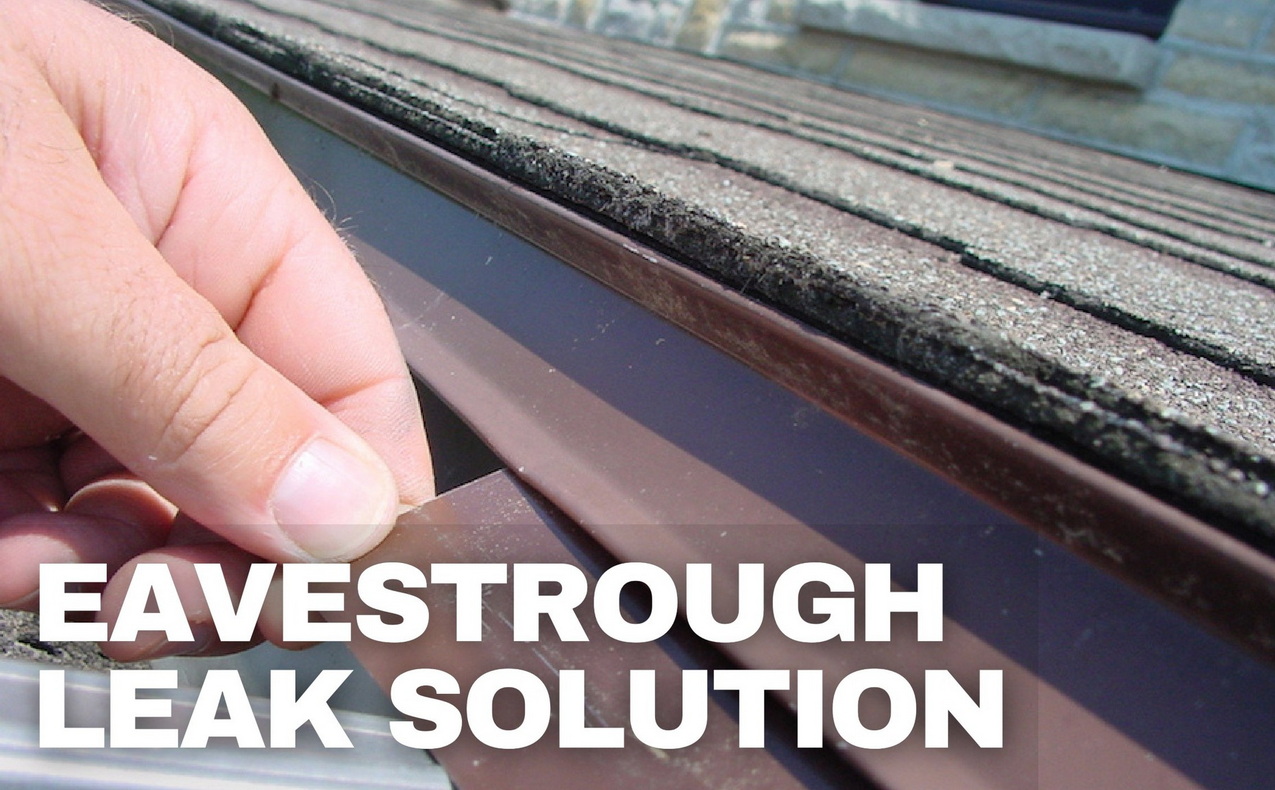Eavestrough leaks are a common issue. Have you got water dripping down behind yours? If so, you should fix it. Here are two options.
If you pay attention on rainy days, you’ll find that eavestroughs don’t always work the way they’re supposed to. And the problem isn’t always caused by leaks in the trough itself.
Rainwater (and melting snow) often sneak around past the back of the eavestrough, wetting the edge of the roof — and potentially triggering rot — eroding the soil on the surrounding ground and causing dirt to splash up against house walls.
It’s an easy thing to miss if you’re not paying attention, and it’s an easy thing to ignore even if you do spot it. But either way, if you’ve got back-of-trough eavestrough leaks happening, then you need to do something about it. And the fix may be easier than you think.
Check your drip edge
The edges of modern roofs are usually lined with strips of sheet metal that protect the edges of wooden roof framing components from getting wet. This is called “starter strip” or “drip edge” in the trade. It always includes a lip that extends downwards about an inch, overlapping the top edge of the eavestrough.
Or at least it’s supposed to overlap. In practice, the lip of the drip edge is often too narrow to properly cover the edge of the eavestrough, allowing water to trickle down behind. If your eavestroughs are leaking, check this cause first.
Solution #1: aluminum fascia

The good news is that there’s an easy solution to back-of-trough leaks, and it begins with a very common building material called aluminum fascia. You’ll find it at every home improvement store.
Buy however many lengths of aluminum fascia that you’ll need to cover the leaky area. Fascia is used on the front edges of roofs, but we’ll be cutting strips off the fascia for use to stop back-of-trough leaks.
You could use any kind of sheet metal for this job, but aluminum fascia that’s prefinished to match the colour of your eavestrough is hard to beat. And, best of all, aluminum fascia is very easy to custom-cut to the width of strip you’ll need for your particular repair.
Place a piece of aluminum fascia, coloured-side down, on a long, flat wooden surface. Next, use a straight edge to guide a sharp utility knife to score the back face of the aluminum along its entire length. You’re aiming to make a strip of aluminum that’s wide enough to tuck under the bottom lip of the drip edge, then extend down and overlap the top, back edge of the eavestrough.
Measure your situation to determine the ideal width of strip required. This strip should rest on the anchors that hold the trough to your house.
Score the aluminum in one deep pass with a utility knife following a long, straight piece of wood, and then bend the metal back and forth a few times by hand. It will break easily along a nice, crisp line, leaving you ready to install the metal. You could use tin snips to cut the strip, but scoring and breaking is faster and neater.
Tuck the aluminum strip underneath the bottom lip of the drip edge, and over top the back edge of the eavestrough where it fastens to the house. This added strip spans the gap between drip edge and eavestrough, covering the place where so many mysterious eavestrough leaks occur.
Watch the video below to see me installing a strip of aluminum fascia behind some eavestrough.
Solution #2: Rainhandler
Are your eavestroughs too far gone to fix? Are you tired of having to keep them clean of needles and leaves on a forested site? There is a way to eliminate troughs altogether, while also avoiding the erosion and structural damage that trough-less roofs cause.
I’ve installed a product called Rainhandler on several of my own buildings and projects, and I can vouch for it personally over 20+ years. It fills an important niche when it comes to rainwater management.
The system uses a series of eaves-mounted louvres to turn roof run-off into droplets again as they leave the roof surface. The droplets are also kicked out and away from the building, keeping walls dry.
I wouldn’t use anything but an eavestrough on homes that require rain to be moved away to keep basements dry, but many places aren’t like this.
Watch the video below to see Rainhandler in action.
So, next time it rains, pay attention to your eaves. Good rainwater management may seem like a small thing, but it matters enough to make a few minutes looking up in the rain all worthwhile.







